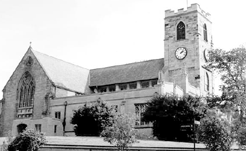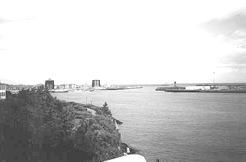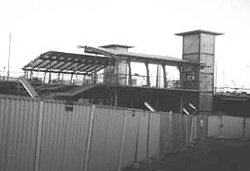Proof exists that a ‘civilisation’ existed in Sunderland as long ago as prehistoric times. But the earliest recorded history dates from the year 674 AD, when Benedict Biscop, who was a Northumbrian nobleman devoted to the church, was allowed to use land by the River Wear to construct a monastery.
The stone and glass construction of the church associated with this monastery quickly developed a reputation for scholarship; it’s most famous academic being the Venerable Bede who went on to become the first important historian.

St Peters Church
Around a decade after the establishment of the monastery, Benedict Biscop was given more land, this time on the rivers southern bank. It is interesting to note that this probably lead to origin of the name of the city. The area was now established on both sides of the River Wear, it was therefore split ‘a sunder’ by the water. Sundered-Land eventually became the shorter and easier to enunciate – Sunderland.

Bishop Wearmouth Church
The Vikings attacked the area in both the 8th and 9th centuries and left the monastery in ruins. It was rebuilt in around the year 900, but the efforts were in vain as the Scots destroyed it again in 1070. A new area was then established at Wearmouth and the area became known as Monkwearmouth, it still carries that name today.
Two more settlements appeared on the south of the river as the years ticked by. They were the port of Wearmouth and the Bishopwearmouth farming community, both established on land owned by the Bishop of Durham.
By the 14th century, coal was being sailed down the River Wear and a 1380 survey tells how ships were being built; yet in 1565, an Elizabethan Commission described Sunderland as a ‘fishing town of thirty households’.

Looking out and beyond Roker Habour
When the Civil War dawned, Sunderland sided with the Parlimentarians and was used as a naval base until the capture of Newcastle upon Tyne from the Royalists in 1644. As a direct result of the war, Newcastle lost its monopoly of the regions coal export and Sunderland gained the upper hand. Many believe this to be the beginnings of the fierce Sunderland-Newcastle rivalry, which continues today.
An increase in river traffic lead to improvements being made to the harbour area throughout the 18thcentury, associated industries such as ropery and sail manufacture also flourished. In 1796, as the town of Sunderland grew in size, the numerous necessary ferries were replaced by an iron bridge.

The Wearmouth Bridge
The many various Sunderland communities were brought together as one in 1832 when Sunderland became a parliamentary borough. By the 1830s Sunderland’s shipbuilding output almost equaled that of all other ports in the country put together and during the 19th century became the world’s largest shipbuilding town.
The introduction of a rail network linking Sunderland to the coal mining industry further increased the towns importance as a port. At this point, Sunderland had also developed its very own Wearmouth Colliery and was gaining a reputation for the production of glass and pottery.
During The First World War, Zeppelins bombed the town but as a result of the war the many shipyards were running at full capacity. Sunderland was then hit hard by the depression and by 1930 shipbuilding had reduced to almost nothing, however the coalmines and the docks did not suffer quite so much. As many as a third of the towns population found themselves unemployed and in the mid-thirties the government attempted to help the worst hit areas by encouraging new industries. Sunderland’s very first industrial estate appeared in the Pallion district of the town in 1938.
Sunderland was one of the most bombed towns in Britain during the Second World War. It was such an important target because of its status as a prolific shipbuilding town, however, rather than reducing the output, it was increased to meet the demands of the supply link from North America to Great Britain which was so important for maintaining the fight against Nazi Germany.
Following World War Two, increased international competition saw shipbuilding in Sunderland enter terminal decline, by the 1980s it had ceased completely with the aid of what many believed to be an unsympathetic Conservative government. Coal mining also suffered in the face of external competition and followed shipbuilding into the local history books in the 1990s.
Today, Sunderland is becoming a thriving City once more with the resurgence of the city’s football team, many high tech companies coming to the area especially to populate the impressive Doxford International Business Park, Nissan still thrives over 38 years since coming to Wearside, the City Centre is being totally revamped with the indoor shopping centre getting a massive extension and the City Centre Mowbray Park being restored to its early 1900s glory.
Work is also now completed on the long awaited Tyne & Wear Metro extension, finally built – a mere 25-30 years late.

The Construction of the
St Peter’s Metro Station
All in all Sunderland is a thriving City and well worth a visit.
